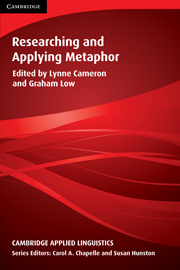Book contents
- Frontmatter
- Contents
- List of contributors
- Acknowledgements
- Conventions
- Series editors' preface
- Preface
- I KEY ISSUES IN METAPHOR RESEARCH
- II FROM THEORY TO DATA
- 4 Getting your sources right: What Aristotle didn't say
- 5 Metaphor and discourse: Towards a linguistic checklist for metaphor analysis
- 6 Identifying and describing metaphor in spoken discourse data
- III ANALYSING METAPHOR IN NATURALLY OCCURRING DATA
- IV ANALYSING METAPHOR IN ELICITED DATA
- References
- Index
5 - Metaphor and discourse: Towards a linguistic checklist for metaphor analysis
Published online by Cambridge University Press: 05 October 2012
- Frontmatter
- Contents
- List of contributors
- Acknowledgements
- Conventions
- Series editors' preface
- Preface
- I KEY ISSUES IN METAPHOR RESEARCH
- II FROM THEORY TO DATA
- 4 Getting your sources right: What Aristotle didn't say
- 5 Metaphor and discourse: Towards a linguistic checklist for metaphor analysis
- 6 Identifying and describing metaphor in spoken discourse data
- III ANALYSING METAPHOR IN NATURALLY OCCURRING DATA
- IV ANALYSING METAPHOR IN ELICITED DATA
- References
- Index
Summary
Introduction
Metaphor research is in need of a comprehensive approach to the language of metaphor in order to give full credit to its linguistic variability, if only so that we can get away from the stale format of A is B (Steen, 1994: 8–9, 243–244; cf. White, 1996; Goatly, 1997). The idea of a linguistic checklist for metaphor was prompted by the linguistic checklist for style presented by Leech and Short (1981; cf. Steen, 1997). My practical interest in such a checklist is its applicability in corpus research, which is where I would like to go next. For if one wants to discriminate between types of metaphor embodying specific configurations of metaphor features of all kinds, corpus research is crucial. Corpus work is also imperative if the object of investigation is the difference between literary and non-literary metaphor, such as I have attempted on a modest scale in my previous work (Steen, 1994). Moreover, corpus research can yield realistic materials for rating studies of metaphor, offering an opportunity to establish the desirable connection between analytic metaphor properties produced in linguistic research on the one hand, and informants' judgements of metaphor on the other. This link was left unexplored in my own work, but it is such an obvious and promising direction of research that it is surprising that it has not been followed more often. Such an approach will eventually also facilitate experimental research on metaphor processing in which metaphor properties can be much better controlled than they are today, or were in my “thinking out loud” studies, reported in Steen (1994).
- Type
- Chapter
- Information
- Researching and Applying Metaphor , pp. 81 - 104Publisher: Cambridge University PressPrint publication year: 1999
- 18
- Cited by

